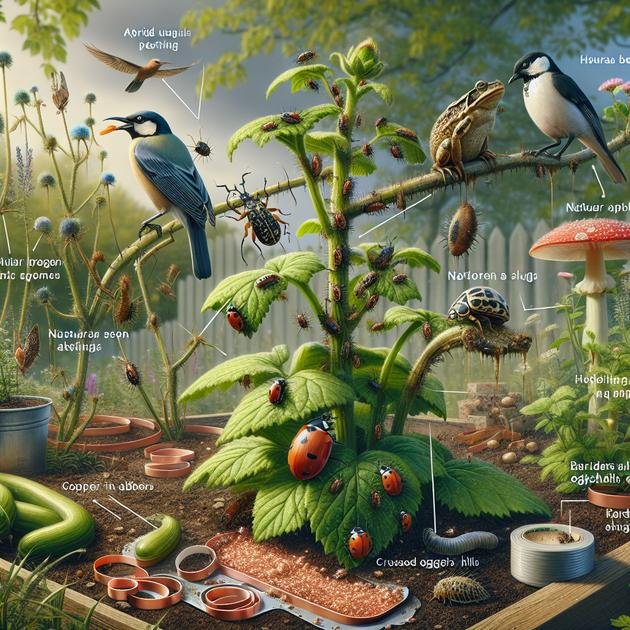Garden pest identification involves recognizing common pests, their natural signs, and seasonal behaviors to apply effective, natural control methods such as companion planting, beneficial insects, and homemade remedies that maintain a balanced and sustainable garden ecosystem.
Garden pest identification can feel like detective work—can you tell a harmless bug from the one munching your leaves? Knowing what’s lurking around your plants helps you choose gentle solutions that protect your garden’s health without chemicals.
common garden pests and how to recognize them
Common garden pests include aphids, spider mites, caterpillars, slugs, and whiteflies. These tiny invaders can damage leaves, stems, and roots, affecting plant health and growth. Aphids are small, soft-bodied insects found on new plant growth, often forming clusters that suck sap and cause leaves to curl.
Spider mites are even smaller and create fine webs on the undersides of leaves. They thrive in hot, dry conditions and cause yellow speckling or bronzing. Caterpillars, the larvae of moths and butterflies, chew large holes in leaves and occasionally consume entire plants if unchecked.
Slugs are nocturnal pests that leave slimy trails and ragged holes on leaves, especially in damp gardens. Whiteflies resemble tiny white moths and hover around plants when disturbed. They feed on plant juices, leaving behind sticky residue that encourages mold growth.
How to recognize these pests easily
Look closely at your plants daily for physical signs like discolored leaves, holes, or sticky areas. Use a magnifying glass to spot the tiny aphids or spider mites hidden under leaves. Check for webs or slimy trails that indicate pest presence.
Knowing the pest’s appearance and damage pattern helps you identify the problem early, making natural control more effective. Keeping a well-lit checklist or photo guide of common pests can be handy during inspections.
natural signs your plants are being attacked
Plants often exhibit natural signs when under attack by pests. Look for yellowing or wilting leaves, which might mean sap is being sucked out. Chewed or ragged leaf edges show that insects are feeding on the foliage. Sometimes, you may notice holes or spots appearing on leaves, indicating leaf miners or fungal infections caused by pest activity.
Sticky residue, known as honeydew, can coat leaves and attract ants or encourage mold growth. This is a clear sign of pests like aphids or whiteflies. Another sign is distorted new growth or curled leaves, often caused by thrips or aphids injecting toxins.
Other indicators to watch for
Brown or black spots on stems may mean boring insects or fungal diseases spreading due to open wounds. Webbing under leaves hints at spider mites, especially in dry conditions. Dead or dying branches and stunted growth can be a sign that root-feeding pests are damaging the plant’s foundation.
Regularly inspecting your plants and recognizing these signs early helps you manage pests with safe, natural methods before serious harm occurs. Keep a close eye on changes in leaf color, texture, and shape to detect pest issues promptly.
using companion planting to repel pests
Companion planting is a natural way to keep pests away by growing certain plants close together. Some plants release smells that pests don’t like or attract beneficial insects that eat harmful pests. For example, planting marigolds near vegetables can help repel nematodes and aphids.
Basil planted alongside tomatoes not only enhances flavor but also deters whiteflies and mosquitoes. Similarly, garlic and chives can ward off aphids and beetles, keeping your garden healthier without chemicals.
How companion plants protect your garden
Certain plants attract pollinators like bees and butterflies, which improve overall garden health. Others draw in predatory insects like ladybugs and lacewings, natural enemies of pests such as aphids and caterpillars. By mixing these plants strategically, you create a balanced ecosystem where harmful bugs decline.
Try planting herbs, flowers, and vegetables in diverse clusters to confuse pests and reduce their impact. Rotating crops alongside companion plants maximizes pest control benefits and keeps your soil fertile.
homemade remedies with ingredients from your kitchen

You can create effective homemade remedies for garden pests using common kitchen ingredients. A simple soap spray made from mild dish soap and water helps remove soft-bodied pests like aphids and whiteflies. Mix one teaspoon of soap with a quart of water and spray directly onto infested plants.
Another popular remedy is garlic spray, which repels a variety of insects. Blend garlic cloves with water, strain the mixture, and apply it to plants. This natural spray is safe for most plants and helps keep bugs at bay.
Other kitchen-based pest control ideas
Mixing baking soda and water creates a spray that combats fungal diseases while deterring some pests. Chili pepper spray, made from crushed peppers soaked in water, can discourage chewing insects like caterpillars.
Remember to test any spray on a small part of the plant first to avoid damage. Using these remedies regularly can protect your garden naturally and reduce reliance on chemical pesticides.
when to introduce beneficial insects to the garden
Introducing beneficial insects is most effective when pest populations start to build up but haven’t yet caused major damage. Early detection through regular garden monitoring helps you time releases carefully to maximize impact.
Ladies, lacewings, and predatory wasps are common beneficial insects that feed on aphids, mites, and caterpillars. Release them in the early morning or late afternoon to avoid harsh sunlight and strong winds, which can harm them.
Signs to know when to release beneficial insects
Look for increased pest activity such as leaf damage, sticky residue, or visible clusters of pests. This signals it’s time to introduce natural predators. Avoid using chemical pesticides before or after because they can kill these helpful bugs.
Also, creating a welcoming environment with flowers and shelter encourages beneficial insects to stay longer, improving your garden’s natural pest control over time.
how to monitor pest populations effectively
Effective monitoring of pest populations begins with regular and careful inspection of your garden. Check leaves, stems, and soil for signs of pests or damage at least once a week. Use a magnifying glass to spot small insects like aphids or spider mites that may be hard to see with the naked eye.
Keep a garden journal to track pest activity, weather conditions, and plant health. This helps you identify patterns and decide when intervention is needed. Setting up yellow sticky traps can also catch flying pests like whiteflies and fungus gnats, giving you an early warning system.
Steps to improve pest monitoring
Divide your garden into sections and inspect each one carefully. Note down the number and types of pests found, along with any damage. Look for eggs or larvae, as early detection can prevent major outbreaks.
Combining visual inspection with traps and records enables a clearer understanding of pest dynamics. This approach allows you to apply natural controls only when necessary, preserving beneficial insects and maintaining garden balance.
the role of soil health in pest resistance
Soil health plays a crucial role in a plant’s ability to resist pests naturally. Healthy soil contains abundant organic matter, beneficial microbes, and nutrients that boost plant growth and immunity. When plants grow strong, they are less attractive to pests and better able to recover from damage.
Microorganisms in the soil help suppress harmful pathogens and support nutrient uptake. This creates a balanced environment where pests find it harder to thrive. Compost and mulch improve soil structure and moisture retention, supporting this protective network.
Ways to maintain soil health for pest resistance
Rotate crops annually to prevent pests that target specific plants from building up in the soil. Avoid excessive chemical fertilizers and pesticides as they can harm beneficial soil life. Instead, use organic amendments like compost, worm castings, and cover crops.
Regularly testing your soil’s pH and nutrient levels ensures your plants get what they need for strong defenses. Good drainage is also important to prevent root diseases that weaken plants and invite pests.
tips for maintaining a balanced garden ecosystem

Maintaining a balanced garden ecosystem requires nurturing diversity and harmony among plants, insects, and soil. Plant a variety of species to attract beneficial insects and pollinators while confusing pests. This diversity supports natural pest control and healthy plant growth.
Use organic mulches and compost to enrich the soil and provide habitat for decomposers. Avoid overusing chemical pesticides and fertilizers as they can harm helpful organisms and upset the balance.
Key practices to keep your garden healthy
Rotate crops yearly and practice companion planting. Provide water sources and shelter like flowering plants and mulch piles to attract beneficial insects. Encourage predators such as ladybugs, spiders, and birds to naturally keep pest populations in check.
Regularly monitor your garden to catch problems early and respond with gentle, natural solutions. By supporting all parts of the ecosystem, your garden becomes more resilient and productive over time.
avoiding chemical pesticides: risks and alternatives
Avoiding chemical pesticides is crucial for maintaining a healthy garden and protecting beneficial insects, soil life, and the environment. Chemical pesticides can harm pollinators like bees, disrupt the natural balance, and lead to pesticide resistance in pests over time.
These chemicals may also contaminate soil and water, posing risks to wildlife and human health. Many pesticides are toxic and can linger in the ecosystem, affecting organisms beyond the targeted pests.
Natural alternatives to chemical pesticides
Consider organic options such as neem oil, insecticidal soaps, and diatomaceous earth, which target specific pests without broad toxicity. Encouraging beneficial insects like ladybugs, lacewings, and predatory wasps can provide natural pest control.
Implement cultural practices like crop rotation, companion planting, and maintaining healthy soil to reduce pest problems naturally. Regular monitoring and early intervention with homemade remedies can further prevent pest damage while avoiding harmful chemicals.
seasonal pest behaviors and what to expect
Seasonal changes affect pest behavior and population growth in your garden. In spring, many pests like aphids and caterpillars emerge as plants start to grow new leaves. Warmer temperatures and longer days encourage their reproduction and feeding.
During summer, pests such as spider mites and whiteflies become more active, especially in hot and dry conditions. These pests can quickly multiply and cause severe damage if not controlled.
What to expect in fall and winter
In fall, some pests slow down while others, like certain beetles and scale insects, prepare for overwintering. They might hide in plant debris, soil, or bark to survive cold months. Winter generally reduces pest activity, but some eggs and larvae can remain dormant, waiting for spring.
Understanding these seasonal behaviors helps plan natural pest control strategies and monitor your garden effectively throughout the year.
best practices for sustainable garden pest control
Sustainable garden pest control focuses on methods that protect the environment, promote plant health, and support beneficial insects. Start by encouraging biodiversity with a variety of plants to create a natural balance. Healthy plants resist pests better and require less intervention.
Use organic fertilizers and compost to improve soil fertility, promoting strong root systems. Avoid chemical pesticides that harm beneficial insects like bees and ladybugs.
Effective sustainable practices
Implement integrated pest management (IPM), combining cultural, mechanical, biological, and chemical controls when necessary. Introduce beneficial insects to keep pest numbers down and use traps or barriers to physically block pests.
Regular monitoring helps catch pest problems early, allowing natural or homemade remedies to work best. Rotate crops and practice companion planting to reduce pest buildup in the soil.
Wrapping up natural garden pest identification and solutions
Understanding how to identify garden pests and their behavior is key to protecting your plants naturally. By watching for early signs, using companion planting, and applying homemade remedies, you can keep your garden healthy without harmful chemicals.
Encouraging beneficial insects and maintaining soil health create a strong defense against pests. Regular monitoring and sustainable practices help balance your garden ecosystem for long-term success.
With these natural strategies, you can enjoy a thriving garden while caring for the environment and supporting nature’s own pest control methods.





